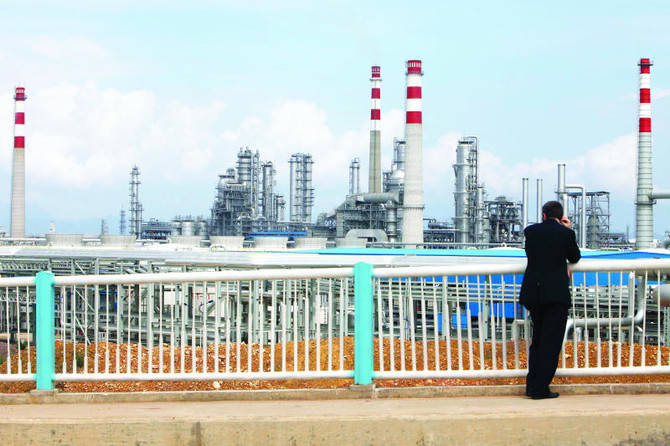BEIJING: China is set to ramp up acquisitions of overseas oil and gas companies to feed its soaring growth in energy demand as the country overtakes the US as the world’s top net oil importer.
Decades of breakneck economic growth pushed China to the top ranking in September, the US Energy Information Administration (EIA) said in a report this week, a position it is set to keep through 2014.
China, already the world’s top importer of a number of commodities, has led worldwide oil demand growth for a good part of the past decade, keeping oil prices elevated even as weak Western economies and rising shale output in the US reduce global consumption.
The long-expected shift may further strengthen China’s position in oil markets as East Asia exerts an increasing influence in global trade.
“Growing imports is going to be a driver for acquisitions,” said Alex Yap, an energy consultant at FGE in Singapore. “From a nation’s point of view, they have a supply security agenda, but from the view of Chinese companies, they are interested to grow themselves into empires.”
Difficulties in boosting domestic output have led Chinese companies, including China National Offshore Oil Co. (CNOOC) and Sinopec, to spend more than $100 billion since 2009 on oil and gas assets to boost imports, Thomson Reuters data shows.
CNOOC aims to double its annual oil and gas output to 120 million tons of oil equivalent from 60 million tons, or 2.6 million barrels per day, by 2020 and to 180 million tons by 2030.
Beijing has also spent billions via subsidized lending and aid to secure oil and gas in Africa and South America.
While China does not bring all the oil from its overseas assets back home, access to the fields gives Beijing security of supplies and allows it to better plan its import targets.
“State traders Unipec and Chinaoil are trading more in the global market than the amount they purchase for domestic refining needs,” said a trading official familiar with China’s crude oil procurement strategies.
“When making overseas acquisitions, they sometimes build refineries as a back-up to secure oil and gas blocks, allowing them flexibility to take either crude oil or refined fuel, or engage in a series of swap deals.”
The EIA figures show that China’s oil consumption outstripped its output by 6.3 million barrels per day (bpd) in September, implying the difference is import demand. The equivalent US gap was 6.13 million bpd.
The drop in US dependence on foreign oil has come from several fronts. New technologies such as hydraulic fracturing, or fracking, have led to a boom in oil production that has reversed a decades-long slide in US output.
US output has jumped by 2.8 million bpd since 2008, recently topping 7.8 million bpd, a level not seen since 1989, according to EIA data. Imports of foreign crude have correspondingly dropped off. So far in 2013, they are averaging the lowest level in 16 years.
At the same time, US refiners have taken advantage of supplies of cheap domestic oil to ramp up throughput. US companies have looked overseas for new markets to supply with fuel as domestic demand declines.
US fuel exports have hit record levels over the past two years, and while the EIA noted the level of overseas shipments could fluctuate in the coming months, the overall trend suggests China will soon open up a significant gap as the world’s biggest net crude importer.
China is already the world’s top buyer of copper, iron ore, soybeans and coal. The country achieved double-digit economic growth for three decades, resulting in increasing demand for fuel, as auto ownership has surged, among other things. Its energy self-sufficiency ended in 1993.
Since then, its oil import dependency has leapt to 58 percent in 2012 and is forecast to reach 70 percent by 2020, consultancy Wood Mackenzie says.
“The center of gravity of the oil market is shifting east as China’s importance in global oil trade continues to increase,” said a London-based oil trader who sells to China.
“Chinese trading houses are setting up offices all over and they aren’t willing to be a regional player but want to have a global footprint. They are very ambitious, very aggressive.”
Growth of China’s domestic oil production peaked at about 2 percent a year in 2001, against consumption growth of 6.3 percent the same year and 4.5 percent in 2012.
China’s increased dependence on overseas supplies has already led to a more than 30 percent jump in crude oil imports from some countries in the Middle East so far this year.
Higher dependence would mean China may have to take on a larger role in international security, including in the Middle East.
China’s assistant foreign minister, Zheng Zeguang, said he has been “paying a lot of attention to this situation.”
“On Middle East issues, China has played a consistent and proactive role to promote the appropriate resolution of hot spot issues,” he said on the sidelines of a forum.
“China will continue to play a role that accords with our national strength.”
China is due to release September oil import data on Saturday.
China ramps up acquisition of overseas oil companies
China ramps up acquisition of overseas oil companies











